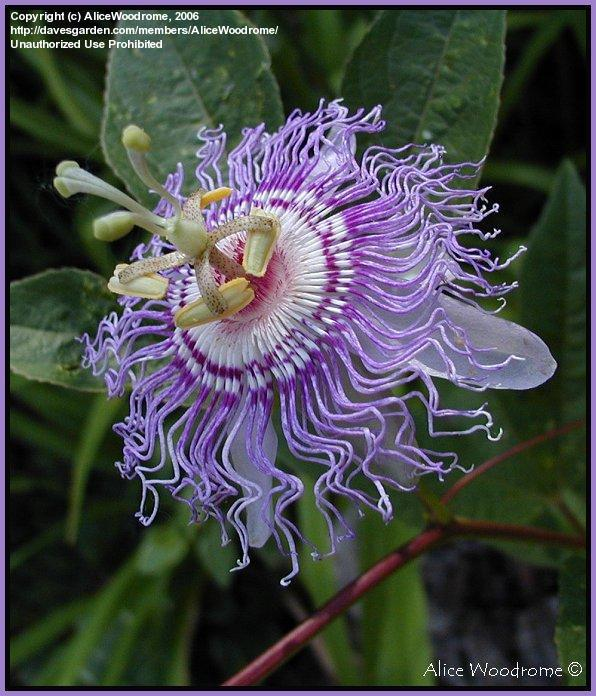
Medicinal Uses
"The Houma, Cherokee and other Native American tribes used purple passionflower for food, drink, and medicinal purposes. Captain Smith, in 1612, reported that Native Americans in Virginia planted the vines for the fruits. The fruits were eaten either raw or boiled to make syrup. A beverage was made from the fruits by crushing and straining the juice. Sometimes the juice was thickened by mixing it with flour or cornmeal. The young shoots and leaves were eaten, cooked with other greens. The roots were used in an infusion to treat boils, and to “draw out inflammation” of wounds from briers or locusts. Babies were given a tea made from the roots to aid in weaning. The roots were beaten with warm water and used as eardrops to treat earaches. Root infusions were used to treat liver problems. Soaking the crushed roots in drinking water made a “blood tonic.” The plant was also used as a sedative to treat nervous conditions and hysteria." (Easyliving Wildflowers, 2009)
Thanks to Alice Woodrome for her permission to use the photo on left. Check out more of her photos of the purple passion flower and other interesting flowers here.
The chart below has many different culture's uses of the Passiflora plants. Though the Passiflora incarnata is not grown in almost all of these countries (see habitat/adaptation), the medicinal use of the Passiflora genus is wide spread. Thanks to Raintree Nutrition Inc. for their permission to use the information chart.
| Worldwide Ethnomedical Uses | |
| Brazil | for alcoholism, anxiety, arthritis, asthma, bronchitis, cough, constipation, convulsions, delirium, depression, diarrhea, flu, gout, headache, heart tonic, hemorrhoids, hyperactivity, hypertension, hysteria, infantile convulsions, insomnia, irritability, menopause, menstrual disorders, nervous disorders, nerve pain, rheumatism, stress, ulcers, urinary insufficiency, whopping cough, worms(intestinal), and as a pain-reliever, anti-inflammatory, antispasmodic, and sedative |
| England | for anxiety, eye problems, headaches, hypertension, hysteria, insomnia, muscle problems, nerve pain, nerve weakness, pain, restlessness, spasms, and as a relaxant and tranquilizer |
| Europe | for agitation, anxiety, asthma, insomnia, irritability, menopause, menstrual disorders, nervousness, pain, palpitations, restlessness, stress |
| Peru | for epilepsy, heart problems, hypertension, insomnia, muscular spasms, nervousness, tetanus, and as an aphrodisiac and sedative |
| Turkey | for epilepsy, insomnia, menstrual disorders, neuralgia, neurosis, spasms, and as a sedative |
| South America |
for burns, colic, depression, diarrhea, dysentery, epilepsy, eruptions, eye disorders, headache, hemorrhoids, hyperactivity, hypertension, hysteria, inflammation, insomnia, menopause, menstrual disorders, nervousness, nerve pain, neurosis, pain, seizures, skin problems, spasms, worms, and as an aphrodisiac, diuretic, and sedative |
| United States | for agitation, anxiety, asthma, burns, depression, diarrhea, epilepsy, headache, hypertension, hysteria, inflammation, insomnia, menstrual disorders, mood disorders, nervous complaints, neuralgia, seizures, shingles, spasms, and as a aphrodisiac, pain-reliever, sedative, and tranquilizer |
| Elsewhere | for anxiety, asthma, epilepsy, heart problems (palpitation, tachycardia) hypertension, hysteria, insomnia, menstrual disorders, mood disorders, neuralgia, nicotine addiction, pain, sexual dysfunction, shingles, spasms |
It should be noted that, as with all drugs, there are precautions to take. Not much official research has been done regarding the purple passion flower and its interactions with the human body. Taking purple passion flower without consent of a doctor, while nursing or pregnant or with high blood pressure may result in serious side effects. These side effects may include: "dizziness, confusion, irregular muscle action and coordination, altered consciousness, and inflamed blood vessels. There has also been a report of nausea, vomiting, drowsiness, a rapid heart rate, and abnormal heart rhythm in one person who took it." (MedlinePlus, 2011 )
Medicinal uses aren't the only interesting thing about the purple passion flower. Follow the link to find out more!
